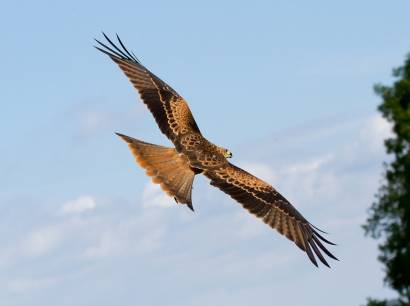This Week's Story
Wilbur Wright: 'I believe that simple flight at least is possible to man...'

This Week’s Story relives American history and the Bible through brief inspiring stories presented on mp3 audio recordings and text for reading.
A First in the Air, part two
“Wilbur, should we get serious about flying? We’ve sold our printing business. Can we build a craft heavier than air that will carry man so he can soar through the air without crashing to the ground?”
“Orville, I’ve been observing hawks and buzzards circling in the sky. They barely flap their wings to stay aloft. Simultaneously they make many little adjustments to the shape of their wings. They slightly move their bodies from side to side. They can glide for hours.”
“How can we apply their steering to an aircraft?”
“Orville, I don’t know, but we know there are four hurdles to flying--the engine, shape of the wings, structure of the flying machine, and the steering. I think we should focus on the controls for steering.”
The brothers didn’t wait. It was 1899. Orville was 27; Wilbur was 32. Neither was married. For years they had been inventors. Already they had been skillfully designing and building kites, inventing new bicycle models, selling and repairing bicycles, and running a printing business. The possibility of flying was a magnet.
Other aviation pioneers were making news. They were experiencing crashes and progress. The question remained: Could man build and fly a heavier-than-air craft?
Wilbur wrote, “Birds are the most perfectly trained gymnasts in the world and are specially well fitted for their work, and it may be that man will never equal them, but no one who has watched a bird chasing an insect or another bird can doubt that feats are performed which require three or four times the effort required by ordinary flight. I believe that simple flight at least is possible to man….”
The brothers began experimenting with how controlling a bicycle might be similar to controlling a flying machine. Both used many small movements to keep balance. Making a craft move straight ahead the brothers understood, but could they make a flying craft turn?
Wilbur made a discovery. “Orville, I slid an inner tube out of a box. I was twisting the box, one end one way and the other end the other way. I looked at it and saw the answer! Wing-warping!”
Soon Wilbur was making the demonstration kite. To his great excitement, the kite’s turns could be controlled.
“Orville, we need to know how big a glider has to be to support a man.” The wings would have to be shaped to provide for lift and drag. The brothers built the glider and tested it at Kitty Hawk, North Carolina.
The glider was off balance. It could glide for three hours, but hold Wilbur for less than ten minutes. Steering was a nightmare and lift and drag did not fit the design equation.
Not until December 17, 1903, did the brothers succeed. It was a cold freezing day. The brothers’ flying machine, the Flyer, was ready. Its engine was started. Orville climbed in, put one hand on the elevator control lever, and with his other hand released the wire that held the machine in place. It moved down a sixty foot long rail until it lifted off. It was in the air twelve seconds and travelled 120 feet. Its fourth flight was fifty-nine seconds and 852 feet. A first in the history of the world!
The Flyer was displayed in the Smithsonian Institution in Washington, D.C. and described as:
“the world’s first power-driven,
heaver-than-air machine in which man
made free, controlled, and sustained flight
invented and built by Wilbur and Orville Wright”
This is Barbara Steiner with a story of remarkable achievement. Please check out thisweeksstory.com.
<< previous story] [next story >>
We invite your comments! [click here to comment]
This Week's Story is a non-profit supported by listeners. [click here to make a donation]
 click here to play audio
click here to play audio